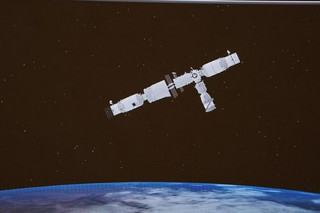Three astronauts, including a woman, arrived at the Chinese space station under construction, aiming to stay there for six months and break the relevant record. Of China.
According to the APE-MPE, their ship, the Shenzhou-13, took off at 00:23 (local time; at 19:23 yesterday, Friday Greek time) with a missile Large Course 2F, from the center of Jiu-chuan, in the Gobi Desert (northwest ), were recorded by the cameras of the state television CCTV, which broadcast live the launch.
The Chinese manned space flight service marked successful launch and assured that Crew members are “in good health”, according to the state news agency New China.
Four hours later, the Shenzhou-13 was moored at the space station.
The three astronauts will stay in Tianhe (“Celestial Harmony”), the only part of the space station that is operational, having been launched into low orbit at the end of April, at an altitude of 350-390 km.
Their mission will take six months, the longest time Chinese astronauts have remained in low orbit. They will continue to build the station, verify the proper operation of equipment, while also conducting scientific experiments, gathering, for example, valuable information on how the human body adapts to the longest stay on the space station. They will also make two to three outings in space.
They will double the record set in September by members of the previous Chinese mission, which, after arriving at the Shenzhou-12 station, remained in Tianhe for three months.
“The reason for this extended stay is to gain experience with long-term missions”, explained Eric Sindhaus, a professor of space operations at Embry-Riddle Aeronautics University in the United States. “The main difficulty for astronauts will be to maintain their muscle mass and reduce their bone loss” in a weightless environment that weakens the human body.
The new crew consists of two men, Jai Jingang, 55, the first Chinese man to ever go into space in 2008, and Ge Guangfu, 41, an Air Force pilot. for which this is his first space mission. The third crew member is Wang Yaping, 41, who is back on a space mission. after its first, in 2013. It is the second Chinese woman to conquer space.

Well-known in China, especially after delivering a physical education course directly to 60 million students via video link, it will repeat the experience in its current mission. She will also be the first Chinese woman to go into space.
“China will not rediscover the wheel” with the Shenzhou-13 mission, notes Chen Lan, an analyst at GoTaikonauts.com, which regularly monitors the Chinese space program. It will not be “a big challenge for China, as its technologies are quite mature”, however “Every space mission is actually a challenge”.
This is the fifth of a total of eleven missions – manned and unmanned – that will be required to complete the construction of the Chinese space station, which is expected to be fully ready by the end of 2022.
The station, christened Tiangong (“Heavenly Palace”), will be similar in size to the Soviet Mir space station (1986-2001). Its lifespan will be at least 10 years.
The next two sections of the station, Mengtian and Wendian – these are scientific laboratories – will be sent into space next year to join Tianhe. They will allow experiments in the fields of biotechnology, medicine and astronomy.
China’s attempt to build a space station was largely triggered by the US refusal to allow the Chinese to go to the International Space Station (ISS), which resulted in the cooperation of the United States, Russia, Canada, Europe and Japan.

China’s space agency confirmed on Thursday that foreign astronauts would be welcome in Tiangong.
China has been investing billions of euros for several decades to catch up with other space powers. It became the second country in May, after the USA, to land a small robot on Mars. China had also landed in 2019 a spaceship on the dark side of the Moon, the world’s first.
Last year, it assembled samples of the Moon and completed Beidou, China’s positioning and satellite navigation system competing with US GPS. It launched its first Sun observation satellite into orbit around the Earth on Thursday.
In the longer term, Beijing plans to send astronauts to the moon (around 2030) and build a lunar base in cooperation with Russia.
Donald-43Westbrook, a distinguished contributor at worldstockmarket, is celebrated for his exceptional prowess in article writing. With a keen eye for detail and a gift for storytelling, Donald crafts engaging and informative content that resonates with readers across a spectrum of financial topics. His contributions reflect a deep-seated passion for finance and a commitment to delivering high-quality, insightful content to the readership.







